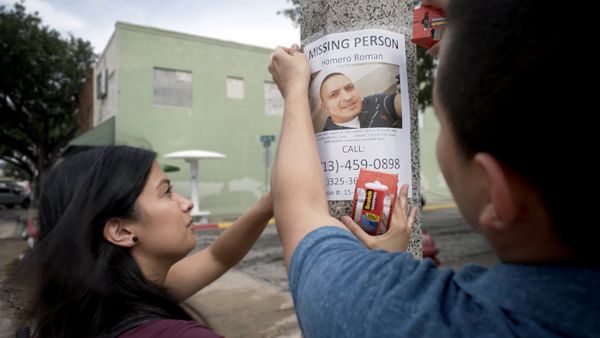Eye For Film >> Movies >> Missing In Brooks County (2020) Film Review
Missing In Brooks County
Reviewed by: Matthew Anderson

"How many people have died along the US-Mexico border?" The size of the decades-long issues at hand in Lisa Molomot and Jeff Bemiss’ Missing in Brooks County are as alarming as they are nigh-on impossible to quantify. Faced with the gargantuan undertaking of exhuming and DNA-matching hundreds of unidentified migrants from traces on the decomposed clothing in which they perished, or from relatives desperate for news of their loved ones, Dr Kate Spradley’s disconsolate rhetorical question hangs in the air, unanswered.
Girding herself for a longer stay in the community of Falfurrias – in the titular southern county – than she and her team had initially expected, as more and more unmarked graves are discovered, the Associate Professor of Anthropology at Texas State University is one of a number of key voices here. With 900,000 square acres of land to cover, and resources stretched so thin as to be non-existent (“The county is broke,” says one sheriff), to suggest that the search for those missing, hoped to be alive but presumed dead, scattered across such an enormous area, is a needle-in-a-haystack task, would be a gross understatement.

And, for some, such goodwill, determination or even any sense of common humanity are in equally short supply. For every Spradley, or Eddie Canales, there may be – the latter a 70-year-old running the South Texas Human Rights Centre, distributing water barrels along commonly-used routes – there are those anti-immigration, Trump-supporting ranchers who stand in opposition to any attempts to assist migrants coming across the southern border. “I’m compassionate,” says one man, as the camera captures dozens of stuffed deer heads on his walls, the sound of Fox News heard blaring in the background. To their credit, there’s no direct interrogation or intervention from Molomot and Bemiss at any point.
Their film is even-handed inasmuch as they do allocate time to such people with the same dispassionate distance. But as they sit and watch Eddie scrub a scrawled “Build the wall now” off one of his many water stations, there’s no doubt as to where their allegiance lies – and indeed their objective in raising awareness of a problem so large as to be difficult to fathom. No doubt biting tongues, they maintain their documentarian’s objective distance even when out on patrol with the ‘Texas Border Volunteers’. Cut from the same cloth as the aforementioned gentleman, albeit camouflaged, and armed with satellite phones and night-vision, they lie in wait at night to then tip off the border patrol or police to “illegal aliens” entering the Land of the Free.
Molomot and Bemiss’ film is at its strongest in observing the plight of the Roman family. Two years since the last news of Homero, the eldest son and one of four siblings, they live in a kind of hollow stasis, unable to grieve or bury any last possible remains, and at the same time still clinging to the last vestiges of hope that he may still be alive. Theirs is one story or many here, and Brooks County is one area of many, many more where thousands upon thousands lay dead, buried and unknown. Just as birds of prey hover high above one corpse found in the opening moments of Missing in Brooks County, the concentric circles of this small-town microcosm spread far and wide. “There is a person inside every one of these boxes,” says Spradley, as shelving units of unidentified remains fill the entire frame, with her work – but most importantly her resolve – far from over.
Reviewed on: 22 Aug 2021
















